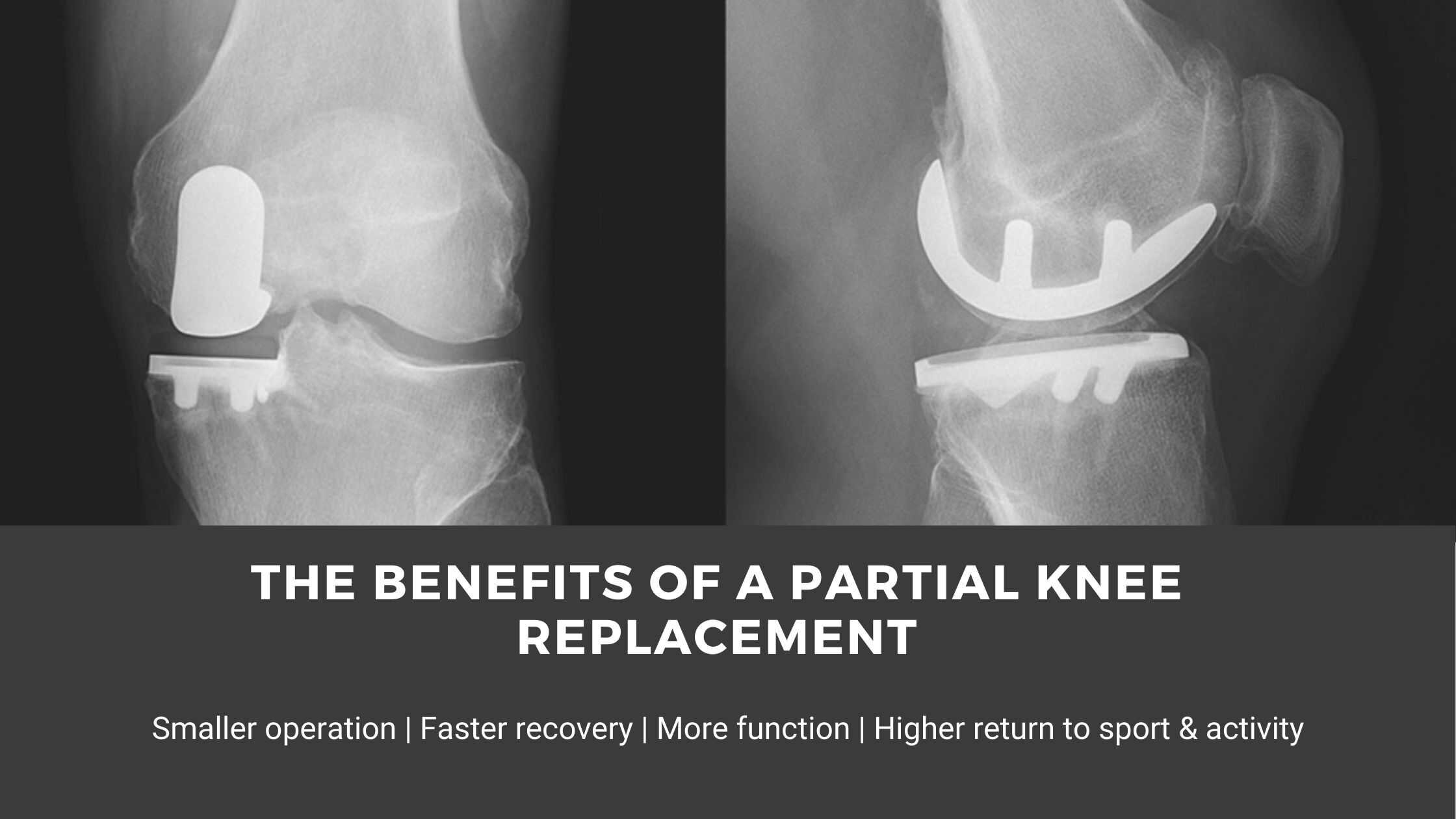The benefits of a partial knee replacement
Your knee has three compartments: the medial, lateral, and patellofemoral compartments. In 50% of knees, arthritis only affects one compartment. If this is the case, you may be a suitable candidate for a partial knee replacement if non-surgical measures have not been effective.
Total knee replacement has a significant dissatisfaction rate
The rate of patient dissatisfaction following a total knee replacement can be high. Some studies quote 15-20%. The rate of dissatisfaction following a well-performed partial knee replacement is lower. This is because the knee is able to function more than a normal knee does. A partial knee replacement preserves the ligaments inside your knee. The other compartments that are not affected by arthritis are left alone. The operation is smaller than a total knee replacement and has less blood loss.
Partial knee replacement has a faster recovery
Patients that have partial knee replacements will recover faster and they’ll have less pain after surgery. Most patients will be discharged 1-2 days following surgery. Six weeks after surgery, their range of motion will largely return. They’ll be off strong pain relief. And they won’t need crutches to get around. After the recovery period, patients are more likely to think that a partial knee replacement feels more like a normal knee than those who’ve had a total knee replacement.
After a partial knee replacement, patients can manage low-impact sports, and they’re more likely to return to sports and activities compared to those who’ve had a total knee replacement. Most studies suggest a return to activity rate of as much as 80-98%. The activities you can expect to get back into are cycling, hiking, tennis, golf and swimming.
Experience in performing unicompartmental knee replacement is essential
The Australian Joint Registry shows that the revision rate of partial knee replacements is between 10-15% percent at 10 years. Although this is comparably higher than a total knee replacement, this can be explained simply. The Joint Registry is the average result of all knee surgeons in Australia. It has been shown that surgeons who have been trained to perform partial knee replacements and do so on a regular basis have a much lower revision rate than those that don’t. Studies have shown that at least 20% of the knee replacements that a surgeon performs should be a unicompartmental knee replacement, to optimise the postoperative outcome.
During his time in the United Kingdom, Mr Pai was trained to perform conventional unicompartmental knee replacements using the uncemented Oxford prosthesis. Worldwide, this is one of the most commonly used prosthesis for a partial knee replacement. Subsequently, Mr Pai trained to use robotic assistance to perform this operation.
Robotic unicompartmental knee arthroplasty has a lower revision rate
Robotic surgery is a useful adjunct when performing partial knee replacement. It can improve the alignment of the knee replacement compared to performing the operation using conventional methods. Early results suggest that robotically assisted partial knee replacements have a lower revision rate. These findings are reflected in the data collected on the Australian Joint Registry, as shown on this graph.
What are the downsides?
Sometimes, arthritis will progress to involve other compartments in the knee, and patients may develop pain from arthritis in a different location. This means that the partial knee replacement will need to be revised to a total knee replacement. This revision is technically straightforward, and it has a high success rate.
Are you a suitable candidate for a partial knee replacement?
If arthritis affects only one knee compartment, and you don’t have a significant deformity or stiffness in your knee, then a partial knee replacement may be suitable for you.
In general, people with rheumatoid arthritis or other types of arthritis with an inflammatory nature, are not suitable for a partial knee replacement because the arthritis may affect all parts of the knee and cause failure.
Mr Pai will obtain a focused series of knee X-rays as well as X-rays from your hip to your ankle. These are called long-limb alignment views. These X-rays allow him to determine which compartments are affected by arthritis, and the overall alignment at your knee. If there is any doubt whether the arthritic process affects other compartments, he will obtain an MRI scan of your knee.
A knee replacement is a major operation that is undertaken in an elective setting, and it’s important to minimise any medical risks associated with the operation. You will be referred to see Mr Pai’s perioperative physician before your joint replacement to ensure that your medical conditions are optimised prior to surgery.
During your operation, Mr Pai’s anaesthetist will ensure you receive the appropriate combination of pain relief during and after the operation to enhance your recovery. Mr Pai will inject a combination of local anaesthetic, an anti-inflammatory, morphine and steroid around the back of the knee and into the wounds, to ensure that you are comfortable after the operation. A unicompartmental knee arthroplasty takes 1 to 1½ hours to perform.
Once the operation is performed, there is a 1-3-day inpatient stay after surgery. You will require outpatient physiotherapy once you’ve been discharged. Mr Pai will work closely with the local physiotherapists in the area to ensure that your rehabilitation is progressing as expected.
Summary
What makes partial knee replacements better?
Smaller operation
Less blood loss
Quicker recovery
Less pain after surgery
Feels more like a normal knee
More likely to return to sports and activities
What are some of the downsides to a partial knee replacement?
Disease progression
Higher revision rate than total knee replacements
This is significantly reduced with experience in UKA, robotic assistance and the right patient selection
Is knee pain affecting your quality of life? Don’t suffer any longer.
Read more about:
Osteoarthritis - What is it and how you can manage it.
Knee replacement - What the procedure involves and frequently asked questions.
Robotic knee surgery - Improving accuracy with knee replacement surgery.
Contact us to arrange a specialist assessment by Mr Pai.


